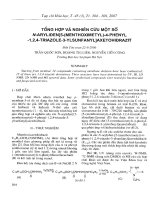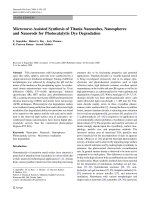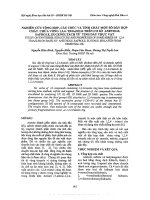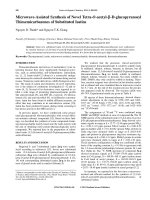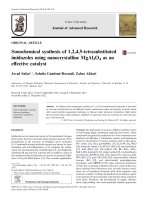microwave assisted synthesis of 1 2 4 triazole 3 carboxamides from esters and amines under neutral conditions
Bạn đang xem bản rút gọn của tài liệu. Xem và tải ngay bản đầy đủ của tài liệu tại đây (599.08 KB, 10 trang )
Res Chem Intermed
DOI 10.1007/s11164-013-1325-7
Microwave-assisted synthesis of 1,2,4-triazole-3carboxamides from esters and amines under neutral
conditions
K. R. Jaisankar • K. Kumaran •
S. Raja Mohamed Kamil • T. Srinivasan
Received: 16 March 2013 / Accepted: 18 June 2013
Ó The Author(s) 2013. This article is published with open access at Springerlink.com
Abstract A series of 1,2,4-triazole-3-carboxamides have been prepared from
1,2,4-triazole-3-carboxylates under mild conditions. Efficient synthesis of amides
directly from esters and amines is achieved under mild, neutral conditions with
liberation of alcohol as by-product. Both primary and secondary aliphatic and
aromatic amines can be utilized. This unprecedented, general, environmentally
benign reaction proceeds in toluene under microwave conditions. The newly synthesized compounds were characterized by spectral and elemental analyses.
Keywords
assistance
1,2,4-Triazoles Á Hydrazones Á Trimethyl aluminium Á Microwave
Introduction
1,2,4-Triazole and its derivatives constitute an important class of organic
compounds with diverse agricultural [1], industrial [2] and biological activities
[3], including anti-microbial [4, 5], anti-proliferative [6], sedative [7], anticonvulsant [8] and anti-inflammatory actions [9]. Pyridine as a heterocyclic nucleus
played a vital role in the development of different medicinal agents and in the field
of agrochemicals. This nucleus is present in many products such as drugs, vitamins,
food, flavourings, plant dyes, adhesives and herbicides. As part of our program
aimed at developing new biologically active compounds, in this work we report the
synthesis of some pyridin-3-yl-1,2,4-triazole-3-carboxamides. This report describes
a convenient alternative synthesis for triazole carboxamides with improved yields.
K. R. Jaisankar Á K. Kumaran (&) Á S. Raja Mohamed Kamil
Department of Chemistry, Islamiah College, Vaniyambadi, Tamil Nadu, India
e-mail:
T. Srinivasan
Department of Advanced Zoology and Biotechnology, Loyola College, Chennai, India
123
K. R. Jaisankar et al.
In the past few years, use of microwave energy to heat and drive chemical reactions
has become increasingly popular in the medicinal chemistry community. This nonclassical heating method has matured from a laboratory curiosity to an established
technique that is heavily used in academia and industry. One of the many
advantages of using rapid ‘‘microwave flash heating’’ for chemical synthesis is the
dramatic reduction in reaction times—from days and hours to minutes and seconds.
It was found that the reaction rate was accelerated by about 50 times under
isothermal microwave condition compared with conventional isothermal condition,
which induces translational and vibrational energy levels and reaction acceleration.
The effect of a microwave field on dielectric materials is to induce rapid rotation of
the polarized dipoles in the molecules. This generates heat due to friction,
simultaneously increasing the probability of contact between the molecules, thus
enhancing the reaction rate and reducing the activation energy. As discussed herein,
there are good reasons why many pharmaceutical companies are incorporating
microwave chemistry into their drug discovery efforts.
Chemistry
1,2,4-Triazole-3-carboxamides used to be synthesized from 4-arylazo-2-aryl-2oxazolin-5-ones reacting with the appropriate amine. Dyck et al. [10] and Lange
et al. [11] prepared 1,2,4-triazole-3-carboxylates and converted these esters to the
corresponding amides by saponification, to give carboxylic acid, followed by
amidation. The 1,2,4-triazole-3-carboxamides 5a–h described herein were prepared
using a different synthetic pathway as outlined in Scheme 1. Diazotization of
commercially available 3-aminopyridine in presence of hydrochloric acid gave the
diazonium salt, which was directly coupled with ethyl 2-chloroacetoacetate to
afford the oxobutanoate 2 [12]. Subsequent treatment with ammonia led to the
amine 3. Cyclization of 3 with phenylacetyl chloride was achieved by refluxing with
toluene. Preparation of the final 1,2,4-triazole-3-carboxamides 5a–h was achieved
by adopting a simple one-pot procedure.
In fact, the commonest procedure to prepare carboxamides of heterocycles
involves three classical steps: hydrolysis of the ester to acid, followed by acid
chloride formation, and finally reaction with the appropriate amine to give the
corresponding carboxamide. Conversion of ethyl esters to carboxamides under mild
reaction conditions via organoaluminium reagents has been described by Benderly
and Stavchansky [13]. Applying this procedure to our 1,2,4-triazole series, the 1,2,
4-triazole-3-carboxamides 5a–h were obtained in good yield in a one-step synthesis
by treatment of the triazole carboxylate 4 with 2 equiv. of an aluminium complex
which was previously prepared in situ by reacting trimethylaluminium with the
corresponding amine. However, trimethylaluminium catches fire spontaneously on
exposure to air and releases flammable gases in contact with water during work-up.
To avoid these practical difficulties, we introduced an atom-economical, environmentally benign direct synthesis of amides from esters and amines under microwave
conditions without any catalyst or metal complex [14–16].
123
Microwave-assisted synthesis of 1,2,4-triazole-3-carboxamides
Scheme 1 (a) (i) NaNO2, aq. HCl, 0 °C; (ii) ethyl 2-chloroacetoacetate, NaOAc, EtOH, H2O, 0 °C;
(b) NH3 gas, THF; (c) phenylacetyl chloride, toluene, reflux; (d) [i] corresponding amines for 5a–h,
Al(Me)3, N2 atm, toluene, 100 °C; [ii] corresponding amines, toluene, MW, 130 °C
Table 1 Conventional heating versus microwave irradiation for amidation reaction
Compound
Product
5a
N
N
N
O
N
N
Conventional method
Microwave irradiation
Time
(h)
Temp.
(°C)
Yield
(%)
Time
(min)
Temp.
(°C)
Yield
(%)
12
100
62
30
130
80
14
100
76
30
130
85
O
5b
N
N
N
O
N
N
N
123
K. R. Jaisankar et al.
Table 1 continued
Compound
Product
5c
N
N
N
O
N
HN
Conventional method
Microwave irradiation
Time
(h)
Temp.
(°C)
Yield
(%)
Time
(min)
Temp.
(°C)
Yield
(%)
14
100
75
30
130
90
14
100
65
30
130
84
16
100
60
30
130
76
18
100
50
30
130
65
16
100
80
30
130
88
12
100
82
30
130
90
N
5d
N
N
N
O
N
NH
O
N
5e
N
O
N
N
NH
N
O
5f
N
N
N
O
NH
N
N
5g
N
N
N
O
N
HN
5h
N
N
N
O
N
HN
O
Experimental
All reagents were purchased from Aldrich and used as received. Dry tetrahydrofuran
(THF), ethanol and toluene were supplied by Spectrochem. All chemistry was
performed under nitrogen atmosphere using standard techniques. Microwave
reactions were carried out with a single-mode-cavity Discover microwave
123
Microwave-assisted synthesis of 1,2,4-triazole-3-carboxamides
apparatus. Microwave experiments were performed in a 10-ml sealed tube. All
nuclear magnetic resonance (NMR) spectra were measured using a Bruker
AMX 400 instrument with 5-mm PABBO BB-1H tubes. 1H and 13C NMR spectra
were measured for approximately 0.03 M solutions in d6-dimethyl sulphoxide
(DMSO) at 400 MHz with tetramethylsilane (TMS) as internal reference. Infrared
(IR) spectra were measured on potassium bromide pellets using a PerkinElmer 1600
series Fourier-transform infrared (FTIR) spectrometer. Liquid chromatography–
mass spectrometry (LC-MS) was carried out using an Agilent 1200 series LC and
Micromass zQ spectrometer. Column chromatography was performed using silica
gel (230–400 mesh). Combustion analysis was performed on a Costech Elemental
Combustion System CHN elemental analyzer.
General procedure for preparation of intermediates
Ethyl 2-chloro-2-[2-(3-pyridyl)hydrazono]acetate (2)
3-Aminopyridine (25 g, 0.265 mol) was dissolved in 250 ml of 6 N HCl (250 ml)
solution to give a clear solution and cooled to 0 °C. Sodium nitrite (18.2 g, 0.265 mol)
in water (50 ml) was added dropwise to the reaction mass and stirred for 30 min at the
same temperature. Later, ethyl 2-chloroacetoacetate (43 g, 0.265 mol) in ethanol
(100 ml) was added dropwise for 1 h at 0 °C. After 30 min, sodium acetate (65 g,
0.795 mol) in water (200 ml) was added dropwise to the reaction mixture and stirred
for 12 h. The precipitated solid was filtered, washed with water, and dried under
vacuum to afford pale-yellow crystals of 2 (4 g, 75 %). M.p. = 124–127 °C. 1H NMR
(400 MHz, DMSO) d 8.72 (d, 1H), 8.63 (s, 1H), 7.63 (d, 1H), 7.26 (d, 2H), 4.54 (q, 2H),
1.46 (t, 3H); 13C NMR (400 MHz, DMSO) d 160.3, 156.7, 150.89, 146.2, 134.5, 133.3,
62.2, 32.6, 14.3; LC-MS 229.04 (M?1); Anal. calcd. for C9H10ClN3O2; C: 47.48, H:
4.43, N: 18.46. Found: C: 47.28, H: 4.63, N: 18.30.
Ethyl 2-amino-2-[2-(3-pyridyl)hydrazono]acetate (3)
Ammonia gas was bubbled through a solution of 2 (10 g, 0.044 mol) at -30 °C for
30 min and stirred at room temperature (RT) for 2 h. Thin-layer chromatography (TLC)
indicated all 2 had been converted to amine 3. The solvent and excess of ammonia were
removed under vacuum; the residue was dissolved in 50 ml of dry chloroform and
filtered to remove NH4Cl. The filtrate was evaporated and triturated with diethyl ether
(25 ml) to afford pale-brown solid of 3 (6.5 g, 70 %). M.p. = 85–88 °C; 1H NMR
(400 MHz, DMSO) d 8.71 (m, 1H), 8.59 (s, 1H), 7.61 (d, 1H), 7.38 (d, 1H), 4.65 (br, 2H),
4.32 (q, 2H), 1.34 (t, 3H); 13C NMR (400 MHz, DMSO) d 159.3, 154.5, 140.2, 134.4,
125.4, 123.0, 116.2, 62.5, 14.1; MS 209.2 (M?1); Anal. C9H12N4O2. C: 51.92, H: 5.81,
N: 26.91. Found: C: 47.98, H: 5.83, N: 26.90.
Ethyl 5-benzyl-1-(pyridin-3-yl)-1H-1,2,4-triazole-3-carboxylate (4)
Phenylacetyl chloride (4.4 g, 0.0288 mol) was added dropwise to a stirred solution of
3 (5 g, 0.024 mol) in toluene (25 ml) at 0 °C. The reaction mass was warmed to RT
123
K. R. Jaisankar et al.
and heated to reflux for 12 h. After completion of the reaction, the solvent was
evaporated. The residue was dissolved in CH2Cl2 (120 ml) and washed successively
with 1 N HCl, 10 % NaHCO3 and brine. The organic layer was dried over anhydrous
Na2SO4 and evaporated under reduced pressure. The residue was purified on silica gel
(hexane/EtOAc 6:4) to give the desired product 4 as a brown gummy solid (0.31 g,
36 %). M.p. = 160–166 °C; 1H NMR (400 MHz, DMSO-d6) d 8.71 (d, 1H), 8.59 (S,
1H), 7.61 (d, 1H), 7.38 (dd, 2H), 7.26 (d, 2H), 7.04 (d, 2H), 4.52 (dd, 2H), 4.24 (S, 2H),
1.46 (t, 3H); 13C NMR (400 MHz, DMSO-d6) d 150.89, 146.24, 133.5, 129.38,
128.34, 127.45, 123.8, 62.23, 32.63, 14.31; LC-MS: 315.4 (M?1). Anal.calcd. for
C17H16N4O2 C: 66.22, H: 5.23, N: 18.17, O: 10.38. Found: C: 66.20, H: 5.26, N: 18.20.
General procedure for synthesis of 1,2,4-triazole-3-carboxamides 5a–h
Conventional method: To a solution of the corresponding amine (1.1 eq.) in dry
toluene (5 ml) was added a solution of Al(Me)3 in toluene (2 M, 2.0 eq.) under N2
atmosphere. The reaction mixture was stirred at RT for 1 h. A solution of 4 (1 eq.)
in dry toluene (6 ml) was then added dropwise. The mixture was heated to 90 °C
during the respective time, then carefully poured onto 1 N HCl (30 ml). The
biphasic solution was heated to 40 °C for 30 min and cooled to RT. The organic
layer was separated, dried over anhydrous Na2SO4 and evaporated. The crude
product was purified by column chromatography.
Microwave irradiation: To a solution of the corresponding amine (1.1 eq.) in dry
toluene (5 ml) was added 4(1 eq.), followed by heating to 130 °C under microwave
conditions for 30 min. The solvent was removed under vacuum, and the crude
purified by column chromatography.
[5-Benzyl-1-(pyridin-3-yl)-1H-1,2,4-triazol-3-yl](morpholino)methanone (5a)
Conventional method: Compound 5a was prepared from 4 (250 mg, 0.8 mmol),
morpholine (83 mg, 0.9 mmol) and Al(Me)3 (3.2 ml, 1.6 mmol); reaction time:
12 h; purified by flash chromatography [pet.ether/EtOAc (4:6)]; yield: 175 mg
(62 %) as brown solid.
Microwave irradiation: Compound 5a was prepared from 4 (250 mg, 0.8 mmol)
and morpholine (83 mg, 0.9 mmol), 30 min; purified by flash column chromatography
[pet. ether/EtOAc (4:6)]; yield: 226 mg (80 %) as brown solid. M.p. = 195–198 °C;
1
H NMR (400 MHz, DMSO) d 8.72 (d, 1H), 8.63 (s, 1H), 7.63 (d, 1H), 7.40 (m, 1H),
7.26 (m, 3H), 7.09 (d, 2H), 4.20 (s, 2H), 3.96 (t, 2H), 3.85 (m, 2H), 3.80 (m, 2H), 3.74
(m, 2H); 13C NMR (400 MHz, DMSO) d 150.6, 146.0, 132.7, 128.9, 128.4, 127.4,
123.8, 67.0, 66.8, 47.5, 42.9, 32.5. LC-MS: 350.3 (M?1). Anal. calcd. for
C19H19N5O2; C: 65.32, H: 5.48, N: 20.04. Found: C: 65.30, H: 5.50, N: 20.07.
[5-Benzyl-1-(pyridin-3-yl)-1H-1,2,4-triazol-3-yl](4-methylpiperazin-1yl)methanone (5b)
Conventional method: Compound 5b was prepared from 4 (250 mg, 0.8 mmol),
N-methylpiperazine (90 mg, 0.9 mmol) and Al(Me)3 (3.2 ml, 1.6 mmol); reaction
123
Microwave-assisted synthesis of 1,2,4-triazole-3-carboxamides
time: 14 h; purified by flash column chromatography [pet. ether/EtOAc (4:6)];
yield: 214 mg (76 %) as off-white solid.
Microwave irradiation: Compound 5b was prepared from 4 (250 mg, 0.8 mmol)
and N-methylpiperazine (90 mg, 0.9 mmol), 30 min; purified by flash column
chromatography [pet. ether/EtOAc (4:6)]; yield: 249 mg (85 %) as off-white solid.
M.p. = 115–118 °C; 1H NMR (400 MHz, DMSO) d 8.71 (d, 1H), 8.63 (s, 1H), 7.65
(d, 1H), 7.36 (d, J = 8.7 Hz, 2H), 7.26 (d, 2H), 7.01 (d, 2H), 4.22 (S, 2H), 3.92 (t,
4H) 2.48 (t, 4H), 2.33 (s, 3H); 13C NMR (400 MHz, DMSO) d 160.0, 157.5, 155.2,
150.5, 146.0, 134.8, 133.6, 132.7, 130.0, 128.9, 128.3, 127.4, 123.8, 55.3, 54.6,
46.9, 45.9, 42.4, 32.5. LC-MS (ESI) m/z: 363.1(M?1). Anal. calcd. for C20H22N6O;
C: 66.28; H: 6.12; N: 23.19. Found: C: 66.30, H: 6.15, N: 23.20.
5-Benzyl-N-(pyridin-2-yl)methyl)-1-(pyridin-3-yl)-1H-1,2,4-triazole-3-carboxamide
(5c)
Conventional method: Compound 5c was prepared from 4 (250 mg, 0.8 mmol),
2-picolylamine (97 mg, 0.9 mmol) and Al(Me)3 (3.2 ml, 1.6 mmol); reaction time:
14 h; purified by flash chromatography; yield: 226 mg (75 %), 270 mg (90 %) as
brown solid.
Microwave irradiation: Compound 5c was prepared from 4 (250 mg, 0.8 mmol)
and 2-picolylamine (97 mg, 0.9 mmol), 30 min; column purification [pet. ether/
EtOAc(5:5)]; yield: 270 mg (90 %) as brown solid. M.p. = 145–148 °C; 1H NMR
(400 MHz, DMSO) d 8.71 (d, 1H), 8.63 (s, 1H), 8.59 (d, 1H), 8.24 (br, 1H), 7.67 (m,
2H), 7.39 (m, 2H), 7.21–7.31 (m, 4H), 7.1 (d, 2H), 4.82 (d, 2H), 4.22 (S, 2H); 13C
NMR (400 MHz, DMSO) d 150.6, 149.1, 146.0, 136.5,132.8, 128.9, 128.3, 127.4,
123.8, 122.5, 122.3, 44.4, 32.6. LC-MS (ESI) m/z: 371.4 (M?1). Anal. calcd. for
C21H18N6O; C: 68.09; H: 4.90; N: 22.69. Found: C: 68.01; H: 4.30; N: 22.30.
5-Benzyl-N-(morpholinoethyl)-1-(pyridin-3-yl)-1H-1,2,4-triazole-3-carboxamide
(5d)
Conventional method: Compound 5d was prepared from 4 (250 mg, 0.8 mmol),
2-aminoethyl morpholine (117 mg, 0.9 mmol) and Al(Me)3 (3.2 ml, 1.6 mmol);
reaction time: 14 h; purified by flash chromatography [pet. ether/EtOAc (5:5)];
yield: 206 mg (65 %) as off-white solid.
Microwave irradiation: Compound 5d was prepared from 4 (250 mg, 0.8 mmol)
and 2-aminoethyl morpholine (117 mg, 0.9 mmol), 30 min; purified by flash
chromatography [pet. ether/EtOAc (1:1)]; yield: 267 mg (84 %) as brown solid.
M.p = 115–118 °C; 1H NMR (400 MHz, DMSO) d 8.71 (d, J=5 Hz, 1H), 8.63 (m,
2H), 7.68 (d, J=8 Hz, 1H), 7.60 (br,1H), 7.41 (m, 1H), 7.21-7.31 (m, 3H), 7.1 (d,
J=5.6 Hz, 2H), 4.22 (s, 2H), 3.72 (m, 4H), 3.62 (m, 2H), 2.63 (m, 2H), 2.53 (m,
4H); 13C NMR (400 MHz, DMSO) d 158.9, 155.9, 150.6, 146.0, 134.7, 133.6,
132.8, 129.5, 128.9, 128.3, 66.9, 56.9, 53.3, 35.8, 32.6. LCMS : 393.2 (M?1). Anal.
Calcd for C21H24N6O2; C: 64.27; H: 6.16; N: 21.41. Found: C: 64.01; H: 6.30; N:
21.30.
123
K. R. Jaisankar et al.
5-Benzyl-N-[(furan-2-yl)methyl]-1-(pyridin-3-yl)-1H-1,2,4-triazole-3-carboxamide
(5e)
Conventional method: Compound 5e was prepared from 4 (250 mg, 0.8 mmol),
furfurylamine (87 mg, 0.9 mmol) and Al(Me)3 (3.2 ml, 1.6 mmol); reaction time:
16 h; purified by flash chromatography [pet. ether/EtOAc (5:5)]; yield: 174 mg
(60 %): 152 mg as brown viscous liquid.
Microwave irradiation: Compound 5e was prepared from 4 (250 mg, 0.8 mmol)
and furfurylamine (87 mg, 0.9 mmol), 30 min; purified by flash chromatography
[pet. ether/EtOAc (1:1)]; yield: 221 mg (76 %) as viscous brown liquid. 1H NMR
(400 MHz, DMSO) d 8.71 (d, 1H), 8.63 (s, 1H), 7.68 (d, 1H), 7.42 (br, 1H), 7.38 (m,
2H), 7.31 (m, 3H), 7.09 (d, 2H), 6.33 (d, 2H), 4.68 (s, 2H), 4.19 (s, 2H); 13C NMR
(400 MHz, DMSO) d 150.7, 146.0, 142.4, 132.8, 129.0, 128.3, 127.4, 123.8, 110.5,
107.9, 36.3, 32.5. LC-MS (ESI) m/z: 360.3(M?1). Anal. calcd. for C20H17N5O2; C:
66.84; H: 4.77; N: 19.49; Found: C: 66.44, H: 4.97, N: 19.69.
5-Benzyl-1-(pyridin-3-yl)-N-[2-(pyrrolidin-1-yl)ethyl]-1H-1,2,4-triazole-3carboxamide (5f)
Conventional method: Compound 5f was prepared from 4 (250 mg, 0.8 mmol),
1-(2-aminoethyl)pyrrolidine (102 mg, 0.9 mmol) and Al(Me)3 (3.2 ml, 1.6 mmol);
reaction time: 18 h; purified by flash chromatography [pet. ether/EtOAc (5:5)];
yield: 198 mg (65 %): 152 mg as dark-brown semi-solid.
Microwave irradiation: Compound 5f was prepared from 4 (250 mg, 0.8 mmol)
and 1-(2-aminoethyl)pyrrolidine (102 mg, 0.9 mmol), 30 min; column purification
[pet. ether/EtOAc(1:1)]; yield: 198 mg (65 %) as dark-brown semi-solid.
M.p. = 142–145 °C. 1H NMR (400 MHz, DMSO) d 8.70 (d, 1H), 8.62 (s, 1H),
7.68 (d, 1H), 7.59 (br, 1H), 7.38 (m, 1H), 7.21–7.29 (m, 3H), 7.09 (d, 2H), 4.21 (s,
2H), 3.62 (t, 2H), 2.75 (t, 2H), 2.61 (t, 4H), 1.81 (t, 4H). 13C NMR (400 MHz,
DMSO) d 158.9, 157.1, 155.9, 150.6, 146.0, 134.7, 133.7, 132.8, 128.9, 128.3,
127.4, 54.7, 54.0, 38.2, 32.5, 23.5. LC-MS (ESI) m/z: 377.4 (M?1). Anal. calcd. for
C21H24N6O; C: 67.00; H: 6.43; N: 22.32. Found: C: 66.91; H: 6.30; N: 22.3.
5-Benzyl-N-cyclobutyl-1-(pyridin-3-yl)-1H-1,2,4-triazole-3-carboxamide (5g)
Conventional method: Compound 5g was prepared from 4 (250 mg, 0.8 mmol),
cyclobutylamine (64 mg, 0.9 mmol) and Al(Me)3 (3.2 ml, 1.6 mmol); reaction
time: 16 h; purified by flash column chromatography. [pet. ether/EtOAc (5:5)];
yield: 217 mg (80 %) as pale-yellow solid.
Microwave irradiation: Compound 5g was prepared from 4 (250 mg, 0.8 mmol)
and cyclobutylamine (64 mg, 0.8 mmol), 30 min; purified by flash column
chromatography [pet. ether/EtOAc (1:1)]; yield: 237 mg (88 %) as pale-yellow
solid. M.p. = 172–175 °C; 1H NMR (400 MHz, DMSO) d 8.71 (d, 1H), 8.61 (s,
1H), 7.65 (d, 1H), 7.39 (m, 1H), 7.21–7.31 (m, 4H), 7.09 (d, 2H), 4.65 (m, 1H), 4.21
(s, 2H), 2.48 (m, 2H), 2.05 (m, 2H), 1.79 (m, 2H); 13C NMR (400 MHz, DMSO)
d158.9, 157.1, 155.9, 150.6, 146.0, 134.7, 133.7, 132.8, 128.9, 128.3, 127.4, 54.7,
123
Microwave-assisted synthesis of 1,2,4-triazole-3-carboxamides
54.0, 38.2, 32.5, 23.5. LC-MS (ESI) m/z: 377.4 (M?1). Anal. calcd. for C19H19N5O:
C: 68.45; H: 5.74; N: 21.01. Found: C: 68.51; H: 5.65; N: 21.10.
N-(2-Methoxybenzyl)-5-benzyl-1-(pyridin-3-yl)-1H-1,2,4-triazole-3-carboxamide
(5h)
Conventional method: Compound 5h was prepared from 4 (250 mg, 0.8 mmol),
2-methoxybenzylamine (123 mg, 0.9 mmol) and Al(Me)3 (3.2 ml, 1.6 mmol);
reaction time: 12 h; purified by flash column chromatography [pet. ether/EtOAc
(5:5)]; yield: 265 mg (82 %) as off-white solid.
Microwave irradiation: Compound 5h was prepared from 4 (250 mg, 0.8 mmol)
and 2-methoxybenzylamine (123 mg, 0.9 mmol), 30 min; purified by column
chromatography [pet. ether/EtOAc (1:1)]; yield: 291 mg (90 %) as off-white solid.
M.p. = 115–118 °C; 1H NMR (400 MHz, DMSO) d 8.71 (d, 1H), 8.63 (s,1H), 7.65
(m, 2H), 7.39 (m, 2H), 7.31 (m, 2H), 7.09 (d, 2H), 6.91 (m, 2H), 4.70 (d, 2H), 4.19
(s, 2H), 3.87 (s, 3H). 13C NMR (400 MHz, DMSO) d 150.6, 132.8, 129.9, 129.0,
128.9, 128.3, 127.4, 123.8, 120.7, 110.3, 55.3, 39.1, 32.5. LC-MS (ESI) m/z: 400.1
(M?1). Anal. calcd. for C23H21N5O2: C: 69.16; H: 5.30; N: 17.53. Found: C: 69.11;
H: 5.38; N: 17.50.
Conclusions
We have developed a simple and efficient method with excellent yields for synthesis of
1,2,4-triazole-3-carboxamides via one-pot synthesis, without using any other
catalysts, in toluene. In this work, eight new compounds were successfully synthesized
using both our reported method and the conventional method. The advantages of the
present procedure are experimental simplicity, easy work-up procedure, mild reaction
conditions and no requirement to use other catalysts. The yield of the present
procedure is comparatively greater than for the conventional method (Table 1), not
only that the unreacted starting materials were isolated from the present work.
Acknowledgments The authors express their profound gratitude to the VME Society, Islamiah College,
Vaniyambadi for the laboratory facilities provided to carry out the research work. They also acknowledge
the help rendered by Dr. Syed Shafi, Department of Chemistry, Thiruvalluvar University, Vellore.
Authors are thankful to NMR Research Centre, Indian Institute of Science, Bangalore and CECRI,
Karaikudi, TN for spectral studies.
Open Access This article is distributed under the terms of the Creative Commons Attribution License
which permits any use, distribution, and reproduction in any medium, provided the original author(s) and
the source are credited.
References
1. S. Bala, R.P. Gupta, M.L. Sachdeva, A. Singh, H.K. Pujari, Indian J. Chem. 16B, 481 (1978)
2. J. Mohan, Indian J. Chem. 22B, 270 (1983)
123
K. R. Jaisankar et al.
3. A. Prasad, R.J. Ramalingam, A.B. Rao, P.V. Diwan, P.B. Sattur, Eur. J. Med. Chem. 24, 199 (1989)
4. A.H. El-masry, H.H. Fahmy, S.H. Ali Abdelwahed, Molecules 5, 1429 (2000)
5. A.S. Orabi, M.A. Moneim, E. El-Din Salem, M. El-Din Abdel-Fattah, Polish J. Chem. 74, 1675
(2000)
6. L.-Y. Wang, W.-C. Tseng, T.-S. Wu, K. Kaneko, H. Takayama, M. Kimura, W.-C. Yang, J.B. Wu,
S.-H. Juang, F.F. Wong, Bioorg. Med. Chem. Lett. 21, 5358–5362 (2011)
7. G. Martin, German Patent, 2,240,043, March 1973. Chem. Abstr. 78, 136302 (1973)
8. S.S. Parmar, V.K. Rastogi, V.K. Agarwal, J.N. Sinha, A. Chaudhari, Can. J. Pharm. Soc. 9, 107
(1974)
9. T. George, D.V. Mehta, R. Tahilramani, J. Davvid, P.K. Talwalker, J. Med. Chem. 14, 335 (1971)
10. B. Dyck, V.S. Goodfellow, T. Phillips, J. Grey, M. Haddach, M. Rowbottom, G.S. Naeve, B. Brown,
J. Saunders, Bioorg. Med. Chem. Lett. 14, 1151–1154 (2004)
11. J.H.M. Lange, H.H. Van Stuivenberg, H.K. Coolen, T.J. Adolfs, A.C. McCreary, H.G. Keizer, H.C.
Wals, W. Veerman, A.J.M. Borst, W. De Looff, P.C. Verveer, C.G. Kruse, J. Med. Chem. 48,
1823–1838 (2005)
12. J.A. Pfefferkorn, C. Choi, S.D. Larsen, B. Auerbach, R. Hutchings, W. Park, V. Askew, L. Dillon,
J.C. Hanselman, Z. Lin, G.H. Lu, A. Robertson, C. Sekerke, M.S. Harris, A. Pavlovsky, G. Bainbridge, N. Caspers, M. Kowala, B.D. Tait, J. Med. Chem. 51, 31–45 (2008)
13. A. Benderly, S. Stavchansky, Tetrahedron Lett. 29, 739–740 (1988)
14. C.O. Kappe, Angew. Chem. Int. Ed. 43, 62506284 (2004)
15. P. Lidstroăm, J. Tierney, B. Wathey, J. Westman, Tetrahedron 57, 9225–9283 (2001)
16. S. Caddick, Tetrahedron 51, 10403–10432 (1995)
123
